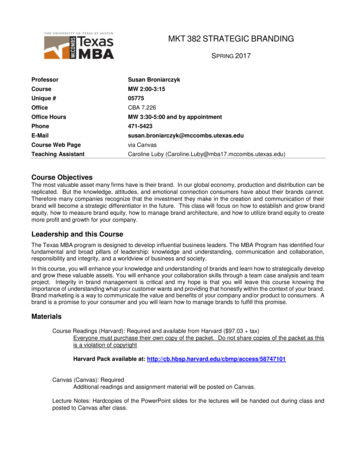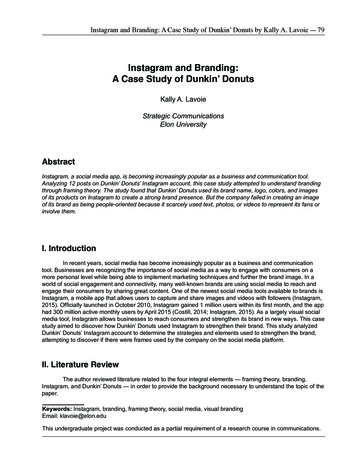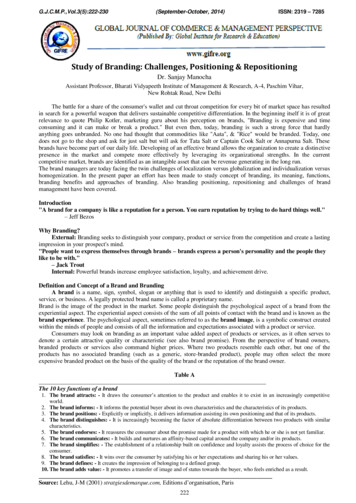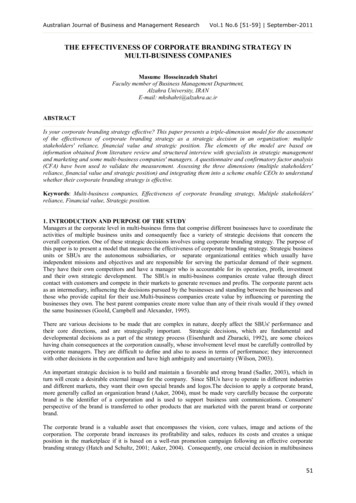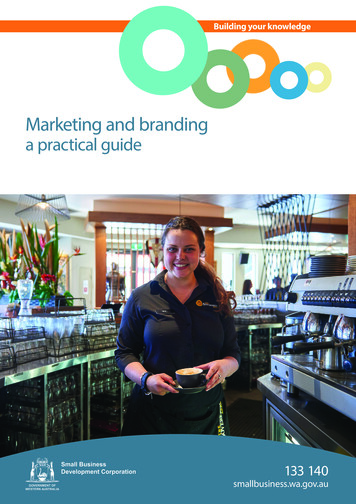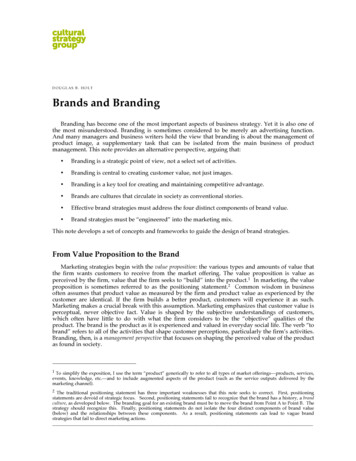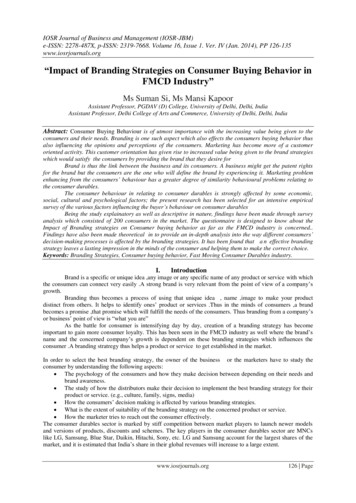
Transcription
IOSR Journal of Business and Management (IOSR-JBM)e-ISSN: 2278-487X, p-ISSN: 2319-7668. Volume 16, Issue 1. Ver. IV (Jan. 2014), PP 126-135www.iosrjournals.org“Impact of Branding Strategies on Consumer Buying Behavior inFMCD Industry”Ms Suman Si, Ms Mansi KapoorAssistant Professor, PGDAV (D) College, University of Delhi, Delhi, IndiaAssistant Professor, Delhi College of Arts and Commerce, University of Delhi, Delhi, IndiaAbstract: Consumer Buying Behaviour is of utmost importance with the increasing value being given to theconsumers and their needs. Branding is one such aspect which also effects the consumers buying behavior thusalso influencing the opinions and perceptions of the consumers. Marketing has become more of a customeroriented activity. This customer orientation has given rise to increased value being given to the brand strategieswhich would satisfy the consumers by providing the brand that they desire forBrand is thus the link between the business and its consumers. A business might get the patent rightsfor the brand but the consumers are the one who will define the brand by experiencing it. Marketing problemenhancing from the consumers’ behaviour has a greater degree of similarity behavioural problems relating tothe consumer durables.The consumer behaviour in relating to consumer durables is strongly affected by some economic,social, cultural and psychological factors; the present research has been selected for an intensive empiricalsurvey of the various factors influencing the buyer’s behaviour on consumer durablesBeing the study explainatory as well as descriptive in nature, findings have been made through surveyanalysis which consisted of 200 consumers in the market. The questionnaire is designed to know about theImpact of Branding strategies on Consumer buying behavior as far as the FMCD industry is concerned.Findings have also been made theoretical in to provide an in-depth analysis into the way different consumers’decision-making processes is affected by the branding strategies. It has been found that a n effective brandingstrategy leaves a lasting impression in the minds of the consumer and helping them to make the correct choice.Keywords: Branding Strategies, Consumer buying behavior, Fast Moving Consumer Durables industry.I.IntroductionBrand is a specific or unique idea ,any image or any specific name of any product or service with whichthe consumers can connect very easily .A strong brand is very relevant from the point of view of a company‟sgrowth.Branding thus becomes a process of using that unique idea , name ,image to make your productdistinct from others. It helps to identify ones‟ product or services .Thus in the minds of consumers ,a brandbecomes a promise ,that promise which will fulfill the needs of the consumers. Thus branding from a company‟sor business‟ point of view is “what you are”As the battle for consumer is intensifying day by day, creation of a branding strategy has becomeimportant to gain more consumer loyalty. This has been seen in the FMCD industry as well where the brand‟sname and the concerned company‟s growth is dependent on these branding strategies which influences theconsumer .A branding stratregy thus helps a product or service to get established in the market.In order to select the best branding strategy, the owner of the business or the marketers have to study theconsumer by understanding the following aspects: The psychology of the consumers and how they make decision between depending on their needs andbrand awareness. The study of how the distributors make their decision to implement the best branding strategy for theirproduct or service. (e.g., culture, family, signs, media) How the consumers‟ decision making is affected by various branding strategies. What is the extent of suitability of the branding strategy on the concerned product or service. How the marketer tries to reach out the consumer effectively.The consumer durables sector is marked by stiff competition between market players to launch newer modelsand versions of products, discounts and schemes. The key players in the consumer durables sector are MNCslike LG, Samsung, Blue Star, Daikin, Hitachi, Sony, etc. LG and Samsung account for the largest shares of themarket, and it is estimated that India‟s share in their global revenues will increase to a large extent.www.iosrjournals.org126 Page
“Impact of Branding Strategies on Consumer Buying Behavior in FMCD Industry”The consumer durables market is divided into two segments – consumer electronics, also known as the browngoods (television, digital camera, audio-video systems, computers, electronic accessories, etc) and consumerappliances or the white goods (air conditioners, refrigerators, microwave ovens, other household appliances,etc.).Objectives1) To identify the various branding strategies and their impact on the consumers‟ decision to purchase FastMoving Consumer Durables.2) To determine how consumer buying behavior gets influenced by various factors that influence theirperception.3) To study the post purchase behaviour of consumers of selected consumer durables.II.Literature ReviewMarketers are the ones who try to satisfy their customers by providing them with the relevant anduseful brands which can satisfy the cunsumers‟ expectations and makes them happyResearchers in marketing have studied most areas of consumer behavior and found out that we have aconsumer driven society where the ultimate motive of the marketers is to satisfy the need of the consumersincluding the impact of how they make their decisions using keeping in mind the various factors or benefits thatthe brand can provide to them. Therefore marketers focus on the basic constructs accepted today in the study ofbuying behavior.Venkateshwar and Rao (2000) have focused on tracing and identifying the elements in consumerdecision-making; the research has studied 200 urban workingwomen belonging to different occupation,educational and income groups. Study observed television as a major source of information, for 65.5%consumers. While group forces affects 50% respondents. Surprisingly 45%-employed women still feel radio as asource of information.According to Schiffman & Kanuk, 2004, different views are considered for understanding consumerdecision making process and behaviour. According to him first is „economic view‟. According to this view pointconsumers are facing imperfect competition in the market and it is expected from the consumers that they havefull knowledge about the products in the market and would make the decision rationally. They can rank thepositivity and negativity about the different alternative in the market and select the best alternative out of all.„Passive View‟. is totally opposite to economic view and according to this view consumers make irrationaldecision as they are very impatient and they easily get influenced by marketer promotional technique. Similarlyaccording „Emotional View‟ consumer make purchasing decision based on their emotional association or feelingabout the products and services. And finally the most acknowledged view is „Cognitive View‟ where consumersare “problem solver‟ Consumer‟s buying behaviour is based on information seeking and processing attributesusually directed by a goal.(Papers4you.com, 2006).Despite all the above mentioned factors ,consumers are also very profound of what they are getting asbrand and its value, popularly known as the brand value which unless and until can influence a consumer‟sbuying behaviour cannot carve a niche for itself in the present competitive era.Batra & Kazmi (2004) asserts broader stages of a consumer‟s decision making process that includesproblem identification (feeling need of a new car), information search ( on internet and showrooms), evaluationof alternatives (comparing brands, for instance‟ on basis of repute and features), outlet selection and purchase (purchasing selected item) and post-purchase action (satisfaction or dissonance).III.Research MethodologyResearch methodology of this study consists of following procedures:Research Design: Being the study descriptive as well as explanatory in nature, sampling, data collection, and itsanalysis has been done sequentially.Source of Data: This study is mainly based on primary data collected through a survey using the questionnairedesigned for this purpose to know about the Impact of Branding Strategies on Consumer buying behaviorrelating to the FMCD inudustry. In addition to this secondary data has also been gathered from various sourceslike newspapers, journals, magazines,books and websites which would enhance and support the conclusionsdrawn.Sampling:Sample size: 200www.iosrjournals.org127 Page
“Impact of Branding Strategies on Consumer Buying Behavior in FMCD Industry”Sampling unit: Individuals at different market places (consumers of consumer durable products)Research Method: Study is based on sampling. Census method which could not be conducted due to the areaconstraint. Sampling would provide a generalized opinion of all the consumer groups on a wholeConsumer Buying Behavior and BrandingA branding strategy basically comprises of consistency, emotional connect, measurement and flexibility.In its initial years, the sector relied greatly on media and advertising for consumer penetration.Liberalisation of markets in late 1990s saw the entry of global players like Samsung and LG and a shift in focustowards product innovation. Accessibility to high-end products was, however, low till mid 2000s. Last few yearshas seen high end and aspirational products like air conditioners and High Definition TVs gain stronghold in themarket.The industry size for consumer durables stands at approx Rs 350 billion . The sector rides and relies onthe state of the country‟s economy. With household incomes in top 20 cities across India expected to grow at 10percent annually over the next eight years, and concepts of easy loans, equated monthly instalment (EMI)charges, availability of credit, etc., become commonplace, the Indian consumer is likely to spend more on bothutility and luxury consumer durable goods.FMCD Industry –An OverviewThe Consumer Durables industry consists of durable goods and appliances for domestic use such astelevisions, refrigerators, air conditioners and washing machines Instruments such as cellphones and kitchenappliances like microwave ovens are also included in this category. The sector has been witnessing significantgrowth in recent years, helped by several drivers such as the emerging retail boom, real estate and housingdemand, greater disposableincome and an overall increase in the level of affluence of a significant section of the population. The industry isrepresented by major international and local players such as BPL, Videocon, Voltas, Blue Star, MIRCElectronics, Titan, Whirlpool, etc.Trends Favoring the Growth of the Consumer Durables IndustryThe key trends that impact the Indian Consumer Durables Industry today can be a variety ofmultifaceted factors.These are discussed separately in the following sections. These trends, over time have gonethrough various changes but they do remain the key factors which determine the growth of any consumerdurable.Increasing Share of Organised RetailThe urban and rural markets in India are growing at an annual rate of 7 to 10 per cent and 25 per centrespectively. One of the key enablers of this growth has been the increasing penetration of organised retail.While there are established distribution networks in both rural and urban India, the presence of well-knownbrands and organized sector is increasing .At present around 96 percent of the more than 5 million retailpremises of all types in India are smaller than 50 sq mtrs. This situation is, however, transforming. Shoppingmalls are becoming increasingly common in Indian cities, and based on plans announced by key developers, aproliferation of new malls is expected over the next three years. Although many of the new malls would bemuch smaller than their western counterparts, Indian consumers will have a far larger number of attractive,comfortable, brand-conscious outlets in which to shop. As a result, the organised retail industry is expected tocover a market share of 15 to 18 per cent by. This will have a positive impact on the consumer durablesindustry, as organised retailing would not only streamline the supply chain, but also facilitate increaseddemand, especially for high-end and branded productsIncome growthNarrowed Price Gap and Increased Affordability of ProductsAdvanced technology and increasing competition is narrowing the price gap between products in thissector, which has driven demand and enabled high growth. Products that were once beyond the reach of themiddle class Indian are now affordable to many. Growth in demand for products, once considered luxuries, suchas air-conditioners, washing machines and high end CTVs, is a reflection of this phenomenon.Entry of Large Players Increasing CompetitionWith potential heavyweight retail stores like Croma, E Zone and Reliance Digital, the high endsegment has been exposed to a new form of purchase, allowing the consumer to feel/experience the product in asuitable ambience (significant in decision-making). Part of the growth momentum in high-end segments ofconsumer electronics could be attributed to the competitive evolution of organised retail, stimulating the demandthrough exposure to high end shopping experiences.www.iosrjournals.org128 Page
“Impact of Branding Strategies on Consumer Buying Behavior in FMCD Industry”Rupee AppreciationRaw material cost constitutes more than 75per cent of expenditure incurred by consumer durablemanufacturers in India. The rapid appreciation of rupee vis-à-vis the US dollar in the recent times is expected toease raw materials costs for Indian manufacturers and benefit those addressing the domestic market.Income Growth and Structural ChangesApart from steady growt
Keywords: Branding Strategies, Consumer buying behavior, Fast Moving Consumer Durables industry. I. Introduction Brand is a specific or unique idea ,any image or any specific name of any product or service with which the consumers can connect very easily .A strong brand is very relevant from the point of view of a company‟s growth. Branding thus becomes a process of using that unique idea .




